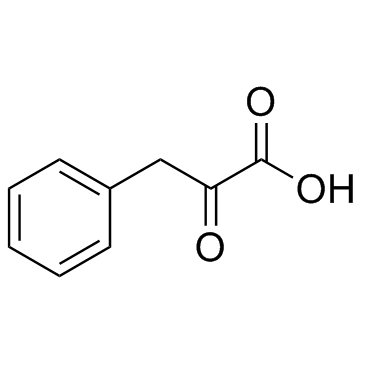2-Oxo-3-phenylpropanoic acid

2-Oxo-3-phenylpropanoic acid structure
|
Common Name | 2-Oxo-3-phenylpropanoic acid | ||
|---|---|---|---|---|
| CAS Number | 156-06-9 | Molecular Weight | 164.158 | |
| Density | 1.3±0.1 g/cm3 | Boiling Point | 299.1±19.0 °C at 760 mmHg | |
| Molecular Formula | C9H8O3 | Melting Point | 150-154 °C(lit.) | |
| MSDS | Chinese USA | Flash Point | 148.9±18.0 °C | |
|
Automated screening of urine samples for carbohydrates, organic and amino acids after treatment with urease.
J. Chromatogr. A. 562(1-2) , 125-38, (1991) Eighty-five clinical urine samples and nineteen urine samples previously found by other laboratories to suggest genetic metabolic defects were prepared for trimethylsilylation by treatment with urease, followed by azeotropic dehydration. The "Target Analyte S... |
|
|
Structural variation governs substrate specificity for organic anion transporter (OAT) homologs. Potential remote sensing by OAT family members.
J. Biol. Chem. 282 , 23841-53, (2007) Organic anion transporters (OATs, SLC22) interact with a remarkably diverse array of endogenous and exogenous organic anions. However, little is known about the structural features that determine their substrate selectivity. We examined the substrate binding ... |
|
|
Resolving phenylalanine metabolism sheds light on natural synthesis of penicillin G in Penicillium chrysogenum.
Eukaryotic Cell 11(2) , 238-49, (2012) The industrial production of penicillin G by Penicillium chrysogenum requires the supplementation of the growth medium with the side chain precursor phenylacetate. The growth of P. chrysogenum with phenylalanine as the sole nitrogen source resulted in the ext... |
|
|
Biotransformation of phenylpyruvic acid to phenyllactic acid by growing and resting cells of a Lactobacillus sp.
Biotechnol. Lett. 29(4) , 593-7, (2007) Phenyllactic acid (PLA) is a novel antimicrobial compound derived from phenylalanine (Phe). Lactobacillus sp. SK007, having high PLA-producing ability, was isolated from Chinese traditional pickles. When 6.1 mM phenylpyruvic acid (PPA) was used to replace Phe... |
|
|
Bioconversion of phenylpyruvate to phenyllactate: gene cloning, expression, and enzymatic characterization of D- and L1-lactate dehydrogenases from Lactobacillus plantarum SK002.
Appl. Biochem. Biotechnol. 162(1) , 242-51, (2010) Two DNA fragments containing the entire coding sequences of lactate dehydrogenase (LDH; ldhL1 and ldhD), whose enzymes have high activity for bioconversion of phenylpyruvate (PPA) to phenyllactate (PLA), were amplified from Lactobacillus plantarum SK002 using... |
|
|
Characterization of D-lactate dehydrogenase producing D-3-phenyllactic acid from Pediococcus pentosaceus.
Biosci. Biotechnol. Biochem. 76(4) , 853-5, (2012) D-Lactate dehydrogenase (D-LDH) from Pediococcus pentosaceus ATCC 25745 was found to produce D-3-phenyllactic acid from phenylpyruvate. The optimum pH and temperature for enzyme activity were pH 5.5 and 45 °C. The Michaelis-Menten constant (K(m)), turnover nu... |
|
|
Characterization of D-lactate dehydrogenase from Pediococcus acidilactici that converts phenylpyruvic acid into phenyllactic acid.
Biotechnol. Lett. 34(5) , 907-11, (2012) The gene coding for D-lactate dehydrogenase (D-LDH) from Pediococcus acidilactici DSM 20284 was cloned and expressed in E. coli. The recombinant enzyme was purified by nickel-affinity chromatography. It converted phenylpyruvic acid (PPA) to 3-phenyllactic aci... |
|
|
Purification and partial characterization of Lactobacillus species SK007 lactate dehydrogenase (LDH) catalyzing phenylpyruvic acid (PPA) conversion into phenyllactic acid (PLA).
J. Agric. Food Chem. 56(7) , 2392-9, (2008) Phenyllactic acid (PLA) is a novel antimicrobial compound synthesized by lactic acid bacteria (LAB), and its production from phenylpyruvic acid (PPA) is an effective approach. In this work, a lactate dehydrogenase (LDH), which catalyzes the reduction of PPA t... |
|
|
3-Phenyllactic acid production by substrate feeding and pH-control in fed-batch fermentation of Lactobacillus sp. SK007.
Bioresour. Technol. 100(21) , 5226-9, (2009) 3-Phenyllactic acid (PLA), which is produced by some strains of lactic acid bacteria (LAB), is a known antimicrobial agent with a broad spectrum. Batch and fed-batch fermentation by the strain Lactobacillus sp. SK007 for PLA production have been reported. Wit... |
|
|
Organic acids in the second morning urine in a healthy Swiss paediatric population.
Clin. Chem. Lab Med. 41(12) , 1642-58, (2003) Organic acid analysis is used for the early detection/ exclusion and for the follow-up of inherited disorders of amino acid and organic acid metabolism. Urinary organic acid concentrations in 417 healthy Caucasian children (1 day to 17 years of age) were dete... |